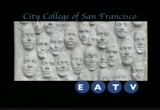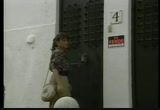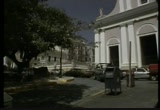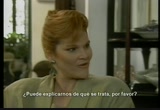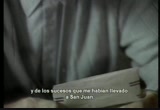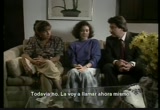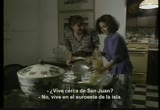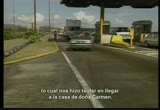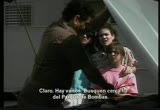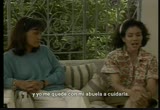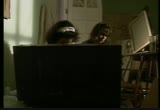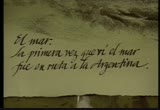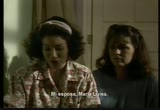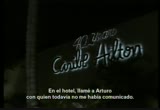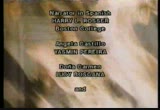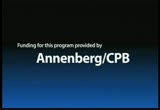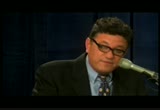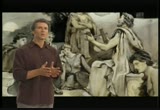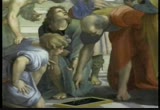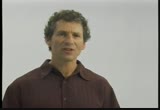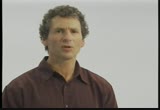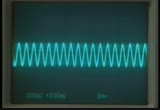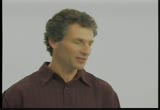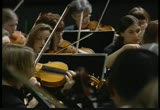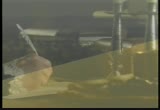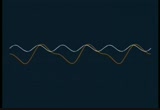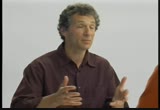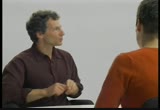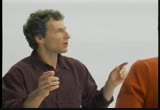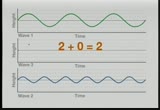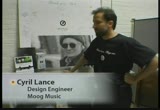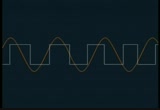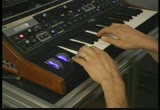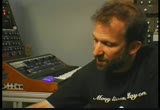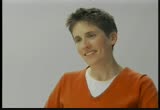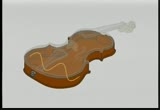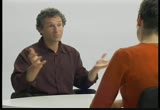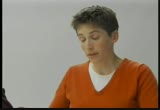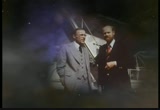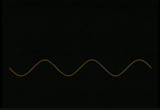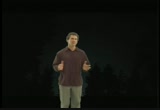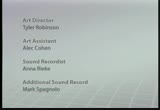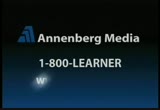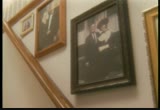tv Democracy Now Special LINKTV November 7, 2012 4:00pm-5:00pm PST
4:00 pm
annenberg media ♪ by: narrador: bienvenidos al episodio 50 de destinos: an introduction to spanish. en este episodio raquel sigue contándole a don fernando y su familia de su investigación. escuchen bien mientras raquel cuenta como conoció a angela y lo que le pasó en puerto rico. carmen: en el nombre del padre, del hijo y del espíritu santo...
4:01 pm
¿qué pasó? su hermano tuvo un accidente en la excavación. captioning of this program is made possible by the annenberg/cpb project and the geraldine r. dodge foundation. entonces, fui a san juan para buscar a angel. disculpe. estoy buscando la calle del sol, número cuatro. la calle del sol, es ésa que está en el frente.
4:02 pm
4:03 pm
nunca se repuso de la muerte de su esposa. ¿entonces era casado? sí, su señora era una mujer muy linda. era escritora. pero murió ya hace varios años. los dos están enterrados en el antiguo cementerio de san juan. buenos días. buenos días. perdone. busco la tumba de angel castillo. siga ud. derecho, hacia la capilla allí doble hacia la derecha. tres líneas más, la encontraré. gracias.
4:05 pm
estoy tomando una foto. ¿de la tumba de mis padres? ¿de sus padres? sí. de mis padres. perdóneme pero... tengo que sentarme. ¿se siente mal? ¿por qué no nos vamos a la sombra? raquel: allí, en la sombra de la capilla le expliqué a angela porque yo estaba en puerto rico y le dije que tenía un tío en buenos aires que no conocía y también un abuelo en méxico. ino lo puedo creer! itengo un abuelo que vive en méxico! así es, ud. tiene un abuelo que vive en méxico. ¿y mi abuelo creía que rosario había muerto?
4:06 pm
exactamente. y rosario también creía que fernando había muerto. iqué historia! tengo que llamar a mi familia. y ud. debe venir conmigo. mi familia querrá hacerle muchas preguntas. imilagro! un lugar donde estacionar. iqué suerte! mi apartamento está a la vuelta. cruzamos la plaza y luego vamos a la derecha. la vecina me dijo que tu mamá era escritora. pues sí, mamá escribía cuentos para niños.
4:07 pm
entra. gracias. itengo una sed increíble! voy a traer limonada para las dos. iperfecto! ah... ties un apartamento muy lindo. gracias. pero voy a mudarme pronto. ¿te mudas? ¿de aquí? ¿por qué? no aguanto este lugar sin mis padres. y tú, ¿cóm puedes viajar tanto? ¿no tienes problemas con la oficina? ¿yo? no. este es un caso especial. además yo llamo a mi oficina de vez en cuando. voy a ver si están mis tíos.
4:08 pm
de acuerdo. mientras esperábamos a los tíos de angela ella me platicó de su familia. en ese momento, supe que angela tenía un hermano. ¿quién es? ah, es mi hermano, roberto. ¿su hermano? también me dijo angela que habían relaciones muy estrechas entre angel y su suegra, la abuela de angela. yo me preguntaba si la abuela de angela, doña carmen sabía algo del pasado de angel. casi todas las madres tienen un hijo favorito. ¿tiene tu abuela un hijo favorito? según mi abuela su hijo predilecto era mi padre que en realidad era su yerno.
4:09 pm
así que había relaciones muy estrechas entre suegra y yerno. eran más que suegra y yerno. eran como madre e hijo. y por fin, llegaron los tíos de angela. como les dije por teléfono raquel nos trae importantes noticias de méxico. ¿puede explicarnos de qué se trata, por favor? raquel: sí, ¿cómo no? deben estar bastante preocupados. el padre de angela, que en paz descanse nunca mencionó nada de su familia ¿trae algún documento? ¿por qué no vino el señor...? ¿cómo se llama? fernando castillo. olga: sí, este señor castillo-- si es el padre de angel, ¿por qué no vino en persona? angela: si la dejan hablar ella contestará todas sus preguntas. bueno, es una historia un poco larga.
4:10 pm
¿desean tomar algo? tengo jugo de parcha. olga: si la dejas hablar, angela quizás pueda contestarnos nuestras preguntas. si me permiten todo empezó durante la guerra civil española. y así, una vez más tuve que contar la historia de mi investigación y de los sucesos que me habían llevado a san juan. y como don fernando está gravemente enfermo en el hospital es importante que angela vaya a méxico pronto. creo que eso va a ser imposible. ¿por qué? angela, no conocemos a esa gente. puede ser peligroso. titi olga, por favor. me imagino que tu hermano no sabe nada de esto. llamé a roberto pero no estaba en su casa.
4:11 pm
nunca está en su casa. no puedes ir a méxico sola. no te preocupes. si quieren saber algo más... olga: yo quiero hacerle una pregunta. ¿por qué angel nunca mencionó a su familia? lamentablemente, no sé la respuesta. angela, ¿hablaste con tu abuela? todavía no. la voy a llamar ahora mismo. ( teléfono suena ) mujer: ¿sí? ioh, angela! ¿cómo estás, querida? sí... ¿cómo dices? ¿a méxico? pero angela, ¿tienes que ir a méxico ahora? sí, abuela. el señor castillo, mi abuelo, está en el hospital.
4:12 pm
está muy enfermo. quiero conocer a esa señorita rodríguez. mañana podemos ir a tu casa. está bien. hablamos entonces. que tengan un buen viaje. gracias, abuela. adiós. un momento, angela. quiero hablar con tus tíos. sí, abuela. mañana voy a su casa. carlos: bien. quiere hablar con ustedes. olga: dámela. yo quiero hablar con ella primero. gracias. ¿mamá? ( habla en voz baja ) iay! iesa olga! ¿viste? la inquisición española. bueno, angela, es que están muy preocupados.
4:13 pm
¿y tu abuela? no te preocupes. ella entiende la situación. porque angel era su yerno favorito, ¿verdad? exacto. mi abuela quiere conocerte. ¿puedes ir conmigo mañana a visitarla? si es necesario para que tú puedas ir a méxico. ¿vive cerca de san juan? no, vive en el suroeste de la isla. mira. allí es. san germán. entonces, al día siguiente angela, yo y una prima suya salimos para san germán. iqué hermoso es esto! ¿qué pueblo es ése? angela: se llama cayey. tiene una magnífica universidad.
4:14 pm
esas montañas son la cordillera central. es una cadena de montañas que se extienden de este a oeste. camino a san germán, tuvimos problemas con el carro lo cual nos hizo tardar en llegar a la casa de doña carmen. iah! iah! iay! iay! ¿qué pasa ahora? vamos, nos falta mucho para llegar a san germán. ¿qué tiene el carro, titi? no tengo idea. perdone. algo le pasó al carro.
4:15 pm
el carro está muy mal. no creo que lo pueda arreglar hoy. ¿qué? estará listo mañana por la mañana. ioh! y ahora, ¿qué hacemos? tendrán que pasar la noche aquí. ¿y cree ud. que podríamos conseguir un hotel? claro. hay varios. busquen cerca del parque de bombas. no fue hasta el día siguiente que llegamos a san germán. bueno, ya hemos llegado. la casa es muy bonita. ahora podremos hablar con tu abuela acerca de ese viaje a méxico.
4:16 pm
¿y yo las puedo acompañar a méxico? cuando estés más grande, laurita. por ahora, lo más lejos que puedas viajar conmigo es aquí a san germán. ¿abuela? iabuela, ya llegamos! hola. idolores! ¿cómo estás? bien. quiero presentarte a raquel rodríguez. dolores acevedo. mucho gusto. el gusto es mío. ¿y la abuela? fue a la iglesia. debe estar por llegar. vamos a buscarla entonces. en el nombre del padre, del hijo y del espíritu santo. amén. señor, ayúdanos en este momento. ayuda a mi nieta
4:17 pm
para que pueda comprender a su padre. padre nuestro que estás en los cielos santificado sea tu nombre... iay, por fin llegaron! iay, abuela! ¿cómo estás? te he extrañado mucho. ¿por qué no vienes más a menudo a san germán entonces? sabes que tengo mucho trabajo. ¿trabajo? iqué va! yo sé que tu tiempo, lo pasas con jorge. iay, abuela! ino vas a comenzar con eso ahora! verás. si lo que te digo de jorge no es verdad. quiero presentarte a raquel. ay, mucho gusto. la estaba esperando. yo también tenía muchos deseos de conocerla. pues, bienvenida a san germán. vamos caminando. tenemos mucho de que hablar. ah, angela, ¿laura comió? por supuesto. siempre tiene hambre esa chica. ilaura!
4:18 pm
me gusta mucho veniesta casa. ¿te gustaría vivir aquí? yo estudié en este pueblo. en san germán hay una universidad. ¿por qué no estudiaste en san juan? al principio, prefería el pueblo. después, mi mamá se enfermó y yo me quedé con mi abuela a cuidarla. carmen: el padre de angela venía todos los fines de semana hasta que murió mi hija. luego dejó de venir. fue una época muy triste. para todos. abuela... quiero acompañar a raquel a méxico. así podré conocer a mi abuelo. ¿y qué? ¿quieres mi permiso? pues, así como te metes
4:19 pm
en mis relaciones con jorge... angela, perdona que interrumpa pero me parece que tu abuela está de acuerdo en que vayas conmigo a méxico. ¿no es así, señora? por supuesto. esta chica tiene que conocer a su abuelo. don fernando se va a poner muy contento. angela, ¿y tu hermano? no hemos podido hablar con él. tío jaime prometió llamarlo ayer. como roberto está en méxico esperamos que pueda ir a la capital. sabes, angela. tú y tu hermano nunca limpiaron el cuarto de tu padre. ay, lo sé, abuela pero está tan desordenado. pues, allí habrá cosas de tu padre. ¿quieres mirar? ¿tú quieres? quizá haya algo importante. posiblemente. pero vamos, que es tarde.
4:20 pm
4:21 pm
"mi padre murió... y yo nunca lo conocí". "estos son recuerdos de mi dura infancia". "el mar. "la primera vez que vi el mar fue en ruta a la argentina". "este es mi hermano arturo "o por lo menos el recuerdo de él. "nos llevábamos como perros y gatos. "me gustaría verlo otra vez. "pero es imposible. es muy tarde".
4:22 pm
"mi madre, icuánto la extraño! a veces siento su presencia". "estos son mis amigos del puerto... los primeros en decirme que me dedicara a la pintura". "mi esposa, maría luisa. "recuerdo de ella su ternura, su voz, sus ojos y su hermoso pelo negro". "mis hijos... ahora lo más importante de mi vida, angela y roberto".
4:23 pm
"el mar. "mi inspiración... y mi destino final". angela. angela, no llores. raquel, no comprendo. estas cosas que mi padre nunca me contó-- ¿por qué? angela... tienes que entender que la juventud de tu padre fue muy difícil. dejar su tierra natal. no tener padre. romper con su familia. era un pasado que él quería olvidar. eso sí lo entiendo. pero, ¿por qué nunca confió en nosotros? eso no lo sé.
4:24 pm
debemos llevar esto a méxico para mostrárselo a don fernando. ¿no crees? también se lo podemos mostrar a arturo. le gustará verlo. sí. esa noche, regresamos a san juan. gracias a dios no volvimos a tener problemas con el carro de angela. en el hotel, llamé a arturo con quien todavía no me había comunicado. arturo no sabía nada de la muerte de su hermano. hola. habla raquel. iraquel! esperaba que me llamaras. ¿qué tal? cómo estás? bien. tengo malas noticias. angel ya...
4:25 pm
¿cuándo? hace unos meses. era un artista muy conocido en puerto rico. y estaba casado. ¿has hablado con su esposa? no. ella murió hace unos años. ( suspira ) angel murió solo, entonces. no. sus hijos estaban con él. ¿sus hijos? así supo arturo que tenía dos sobrinos y hablamos sobre encontrarnos en méxico. después, saliendo del hotel de san juan supimos que hubo un accidente en la excavación. jorge: iangela! si no salimos para el aeropuerto ahora no vamos a llegar a tiempo. tiene razón. se hace tarde. trataré de llamar desde el aeropuerto y si no, llamaré tan pronto como lleguemos a méxico.
4:26 pm
4:27 pm
4:28 pm
sipc. c-i- lo siento, roberto. eso es incorrecto. lisa flores. lisa, tu palabra también es 'sipc'. ¿podría tenerla en otra oración, por favor? los fondos de sipc están disponibles para satisfacer las reclamaciones de los clientes de firmas de corretaje hasta un máximo de $500,000, incluyendo hasta $100,000 por rec 'sipc', eftivo s-i-p-k. ¿no conoce a sipc - securities investor protection corporation? no importa. se lo deletrearemos. visite nos www.sipc.org.
4:30 pm
4:31 pm
cosmic waves bathing the universe. all of it explained, illuminated, and connected via mathematics. sometimes we call it harmonic analysis, other times we call it spectral analysis, but most people call it fourier analysis. of all these sensory experiences, perhaps music more than any other is the one that is most closely associated with mathematics. the greeks believed that beautiful music was mathematically based music and that there was a mystical connection between music and mathematics, that music was actually the mathematics of time. throughout history, music has been at the heart of human culture. its origins were most likely the patterns, rhythms, and tonalities of nature, sounds adapted and organized by humans to create melody, harmony, and rhythm. some of the earliest instruments were as simple as clapping hands. but it was the ancient greeks who first laid the foundations
4:32 pm
of our understanding of harmonics, how vibrating strings and columns of air produce overtones which are mathematically related. in fact, the word "music" itself derives from the muses, daughters of zeus and patron goddesses of creative and intellectual endeavors. the greeks applied the same rigors of rational thought to music as they did to everything else. pythagoras is said to have made the earliest acoustical observations when he described the arithmetic ratios of the harmonic intervals between notes, ratios which were based on the length of the object creating the sound. for example, octaves, 2:1. fifths, 3:2. and fourths, 4:3. for the greeks, these arithmetic ratios held great metaphysical significance because they believed that a single set of numbers from one to four was the source of all harmony. so their theories about music were intricately connected to their mathematical and
4:33 pm
philosophical description of the universe: how the planets, the sun and the stars vibrated in harmony, creating a "music of the spheres." in the ensuing 2,000 years, we've learned that this connection between math and music, whether mystical or not, is all about waves. sound is simply a disturbance of air, as pythagoras observed, a vibration, but as we now understand, a vibration that extends through space in the form of a wave. the initial disturbance can be caused by anything, and that anything is called an oscillator, like a vibrating string. but like ripples on a pond, the sound wave spreads when molecules in the air are disturbed and themselves begin to vibrate. the vibrating air molecules, in turn, bump into other nearby molecules, causing air pressure to compress and expand. this changing air pressure creates alternating waves that extend from the source of vibration. if a person is in the path of
4:34 pm
the sound wave and then the wave enters the ear, it's rapidly processed and recognized by the brain as sound. there are many different kinds of sound waves, but they all begin with a simple sinusoid, like this. [ plays sustained low note ] this is a perfect "a." and this, the s-curve, is the sinusoid that represents the sound. sinusoids are one of the simplest forms of what a mathematician would call a periodic function, which is a function that repeats over and over...or cycles through a specific period of time. we use the sinusoid to represent the periodic behavior of sound in its simplest, purest form. it's the most basic wave, moving in a simple harmonic motion with a perfect pattern of peaks and troughs. sinusoids are largely determined by two basic characteristics: amplitude, how high the wave goes up...and wavelength, which
4:35 pm
is the distance from trough to trough, or equivalently, frequency, which is the number of waves per unit length. amplitude and frequency have immediate psychoacoustic correlates as loudness and pitch. as you can see, the greater the disturbance, the greater the amplitude and the louder the sound. frequency is simply the number of waves in a given interval. the higher note has a higher frequency than the lower note. so frequency is a measure of pitch, and the geometry of these sinusoids explains why, when we play the higher and the lower a together, they sound good together. the sinusoids from each of these two notes fit perfectly inside one another. the higher a is the lower one squashed by one-half. of course, not all waves are perfect sinusoids. there are all sorts of waves. different objects create different types of waves, therefore different types of sound.
4:36 pm
strings are the source of some of the most beautiful music on earth. they have so many interesting characteristics. watch. [ plays low note ] when we play different strings, we create different sounds, therefore differently shaped sound waves. [ plays scale of notes ] the same thing happens when you pluck the same string at different positions. or when you play strings on different instruments. in each case, you create different sounds, therefore different sound waves. and when a variety of sound waves of different amplitudes, frequencies, and shapes are combined, we have music. [ playing song ]
4:37 pm
[ classical music plays ] but the music of the real world is comprised of complicated sound waves, not the simple, pure sinusoids we've just discussed. in fact, most sounds are composed of complicated waveforms, whether we're listening to a single instrument or a symphonic orchestra. and while the greeks may have deconstructed music into simple arithmetic ratios such as octaves, fourths, and fifths, how can we mathematically understand such complexity? for centuries, we couldn't. not until the early 1800s, when the eccentric french mathematician jean baptiste joseph fourier discovered that waves can be combined and separated. it was a discovery that no one believed at first but that changed music and math forever. fourier's revelations didn't begin with music, but rather,
4:38 pm
with his investigation of heat. friend and advisor to napoleon, fourier is said to have become obsessed with heat while accompanying bonaparte as chief science advisor on the 1798 military expedition to conquer egypt. fourier was apparently so impressed by the well-preserved sarcophagi that he kept his rooms uncomfortably hot for visitors while also wearing a heavy coat himself. the heated problem that fourier took on in his famous memoir, on the propagation of heat in solid objects, was the problem of heating and cooling of our earth, our own cycle of temperatures. the french mathematician developed his understanding of heat flow in terms of newton's law of cooling that says that the movement of heat between two bodies is proportional to their temperature difference. translating this to the infinitesimal scale of temperature differences between infinitely close positions in an object gives the famous differential equation called the "heat equation." in fourier's solution of the heat equation, he found these
4:39 pm
periodic solutions of sinusoids mirroring the cycle of teeratures over the year as the accumulation of periodic effects, such as the regular orbit around the sun and the daily spinning of the earth on its axis. fourier found that no matter how complicated a wave is, it's the sum of many simple waves. this was an astounding discovery. but for many years, few people believed his theories. after all, how could a complicated wave be reduced to the sum of seemingly many incompatible shapes: square waves and v-shaped waves have corners, while sinusoids are smooth. but over time, mathematicians affirmed fourier's discovery and came to refer to the unique set of simple waves that combine to form a more complicated wave as the wave's fourier series. so we're here with liz stanhope, professor of mathematics at lewis & clark college, and liz's research expertise lies at the intersection of fourier analysis and geometry. hi, liz. >> hi, dan.
4:40 pm
>> we're going to talk a little bit about fourier, and my understanding is that when fourier introduced this at that time, i guess, it was an impossible idea that any function could be represented as a sum of sines and cosines. people didn't really believe it. >> yeah, it seemed sort of surprising to do arithmetic with waves. i mean, you're adding and subtracting things that aren't functions. that seems like a surprising idea to come up with. >> and it was even more than that, because it wasn't just, well, you take maybe three of these waves, which people maybe could think about, because it was like three things, but he was actually saying, you know, you could take an infinite number, is that right? >> you might even need an infinite number to get at what you're trying to construct. >> at that time, notions of like summing an infinite number of functions was a very complicated thing for people to think about. the real sort of stopping point for people were what we call questions of convergence, right? so if you add an infinite number of things, what are the conditions under which that could have a finite limit, something bounded? let's talk a little bit about, you know, fourier analysis of a
4:41 pm
simple function. fourier is claiming that this thing really is a sum of sines and cosines, so i mean, how does that work? >> so you can decompose it. so you take your squiggly thing, and using fourier analysis, you can decompose it into its fundamental parts. and its parts will be simple sine waves or cosine waves. >> so fourier analysis is almost like a prism -- >> absolutely. >> is the way that i like to explain it sometimes, right? so in the sense that you can be given light, it passes through newton's old prism there, and there you see all the components, the sort of pure frequencies of light, right? >> you'll take your complicated function and, using this mathematics, pull it apart. so you might have a sine wave with a certain period as one of its fundamental parts, and then maybe a cosine with a slightly tighter frequency on there as another fundamental part. and it'll tell you how much of each of those show up. >> what does it mean to add waves and get another wave? >> let's start with two waves, just to make it small. so let's start with one wave that has one oscillation per
4:42 pm
unit, and let's add it to a wave that has two oscillations per unit. so we can start with those two. and so we have these two waves. how do we add them together? they're not numbers, it seems a little odd. >> and i also notice that one of them is sort of bigger than the other. >> so one of them has an amplitude of 3, and the other has an amplitude of 1, so one of them, the bottom one there, is going to oscillate a little bit with less amplitude there. >> so there are a number of parameters, actually, that we need to describe any wave. so we're going to be talking about sine waves, so our waves are pinned at one end. >> absolutely, yeah. >> and then there's the maximum height they can go to. >> so that's your amplitude. >> and then there's the number of times we sort of fit it into an interval, and that's the -- >> that's your frequency. >> so we've got waves of different frequencies, different amplitudes -- >> but both sines. so we'll make it easy. yeah, so let's start where they're both pinned, and we'll start adding there, because it's the easy part, right? so they're both pinned all the way on the left, so how do we add those two waves together there? you just start with that point where they both start, and how high are they away from that axis that they oscillate around? they're on it. >> they're on it. >> so they're not any height.
4:43 pm
so they're both 0 value there. so add those zeros together, and that's your first point in the sum. and now cruise along and choose any other point on that axis that they both oscillate around, and then, see the height of the first function above that point? check out the height of the second function. >> so those are going to be two numbers, a positive if it's above, a negative if it's below, and i'm just going to add them? >> you add them together and then plot it above, yeah. >> right, and so there's the sum of those two waves directly calculated beneath it. and so now we're going to do it at every single point along the curves, right? >> mm-hmm, and just bring it all the way across. >> there we go. wave one plus wave two is wave three. so not really much different from adding numbers, ultimately. >> nope, there's just a lot of them, yeah. >> right. infinitely many, in fact. >> indeed. >> we did use simple addition on the one direction, but going backwards actually requires calculus. >> absolutely. >> but machines do it. those are exactly sort of the machines that show us, for example, that when you hear a tone from an instrument, that it's composed of particular frequencies of particular amounts, right? and there's a fundamental
4:44 pm
algorithm which is very near and dear to me, because it's my work, which does this, and it's called the fast fourier transform, which really underlies sort of all of modern digital technology. >> it undoes all of your odd waveforms into their component pieces. >> and you can start manipulating the frequencies. [ synthesizer plays ] >> welcome to moog music. we build analog musical synthesizers in the tradition of bob moog, who is one of the pioneers of electronic music. my name is cyril lance, and i'm a design engineer here. let's take a little tour of the factory. all right, here we are out on the production floor. this is where we build all our synthesizers and musical equipment. this is where we install all the circuit boards, and aaron is taking our front panels and putting everything together so that we can start attaching the actual circuits. synthesizers, as we make them,
4:45 pm
are electronic instruments. and they can have the form of a keyboard or they can have the form of a module that can be controlled by many things: pedals, any type of input device. the synthesizers create sine waves. a sine wave is a periodic waveform, and it's really one of the pure waveforms. sine waves relate to fourier series, which is a big, big deal in the kind of fusion of math and sound. fourier came up with this equation that said any arbitrary function or complex waveform that varies in time can be described with a series of cosines and sines. this was a very, very powerful mathematical leap at the time, and it really has had profound effects on everything we do in terms of electronics, because basically it means that we can break down any phenomenon that we either observe or want to create in nature into a set of sines and cosines.
4:46 pm
acoustic instruments typically are limited in their sound capability by the physics of an instrument. for instance, an acoustic guitar can only vibrate in certain ways, and when you hit a string, that string can only oscillate in certain modes and excite certain frequency resonances of the cavity of the guitar, same as a violin or a bass or a flute. an electronic instrument usually has a lot wider variety of expression and tones that it can get. this is close to a sine wave here. like a single oscillator making a periodic waveform that i can control the amplitude to, which is how loud it is -- louder and softer -- and the frequency of, if i play an octave down, you see, the frequency is how many times per second that waveform vibrates. so in our synthesizers, i can take an oscillator, but i can also change the shape. so you can see that just by varying the way the waveform looks, you can get a lot of
4:47 pm
different types of sounds. this is a square wave, which is a really recognizable sound in electronic music. this has kind of got a buzzy edge to it, and you can see it's got a lot of harmonic content to it, which means that there's a lot of sines and cosines going out into a high frequency. if i break that down and just add the first sine wave, you see that the major sine wave has a period the same as the square wave, but it doesn't sound like a square wave. now i've added something at twice the frequency, it kind of looks like a molar of a tooth, but you can see it's a lot closer to a square wave now. and as i keep adding higher and higher frequency sine waves, you can hear that it's getting to sound more and more like a square wave, and as you see, the additive wave form, the sum of all those sines, is looking more and more like a square wave. so i keep going, you can even hear the higher harmonics coming up here. hear "wee-wee-wee," way up high?
4:48 pm
and the higher you go, the closer and closer it gets to a square wave. and now, if you keep adding a whole bunch of them, it sounds a lot like a square wave. so let me turn that off, because it gets annoying listening to a square wave like that. so that's kind of a good demonstration of how sine waves and cosine waves, when you add them together in a proper way, can approximate a waveform. we're in a very exciting point in the history of electronic music, because there is so much capability. moog is dedicated to expanding the sound vocabulary, giving musicians the ability to create sounds that nobody's ever heard before. so using these basic math principles, our mission is to expand the vocabulary that musicians and human beings can use to create sounds. >> now, that was great. so this really is fourier
4:49 pm
analysis in action, right? >> i would love to be able to do that for a doughnut shape, to be able to control exactly what sounds i'm hearing. it's wonderful to see someone who can actually produce the sounds, the frequencies, and the waveforms at the same time. >> he really feels like he's really manipulating sines and cosines. >> that's great that you could give him a waveform and he can come up with a sound that fits that wave form; it's just wild. >> so this discussion that we've been having is starting to resonate with me, for lack of a better word, and resonating back to what we talked about originally with the greeks. so the greeks had this mystical feeling. i mean, mystical as well as sort of, you know, sensory, that strings that were of commensurate length would sound nice together if you plucked them, okay, that they'd be harmonious. and in fact, we sort of see that mathematically, they were sort of right with this work, right? >> those frequencies are integral multiples of each other, so you're getting a very nice progression of frequencies mathematically coming off of the string, yeah. >> that's right, so what we're seeing here in the overtones is
4:50 pm
that -- so we're getting multiples of frequencies, so we are actually seeing this kind of integer relation between them. >> even though the sound of a violin is coming from a much more complicated shape than a simple string, you still get to have that nice progression of frequencies. >> with the instruments, we've been folding in now a little bit of two-dimensional stuff, is that right? >> it's even three-dimensional. think of interior of a violin resonating. what are the harmonics of that sort of piece of space? and for me what it would mean is just the -- there are natural ways waves propagate through that space, and they're associated to frequencies, so to me the harmonics of the interior of that violin are just those frequencies of the waves that fit nicely inside the violin. >> now, a musician, an expert in music, could clearly hear the sounds off the violin, off the bass, and say, "all right, that one's a violin, that one's a bass," even if they were both trying to play a, for example. but this very general question of, you know, does the frequency content sort of identify the source is one that you've been thinking about, right?
4:51 pm
>> mm-hmm, so a fun thing you can do is take a piece of paper, cut out whatever shape you want. so if you're feeling simple, you could do a square or a disc or something like that, and each of those will have their own harmonics. >> okay, so i've got my scissors and i make these patterns, and now i create drums that look just like those patterns, maybe two drums like that. and so now you're telling me, or we're hoping, in fact, that what i could do is i could thwack those two drums and have a blindfold, you have a blindfold, and you say, "oh, that one came from the circle, and that one came from the square." >> what you could do is you thwack each of your shapes and you write down the frequencies. so it could be an infinite list of frequencies that you're hearing, so you have that sound, and then with those frequencies, those numbers, maybe there's a hope of figuring out which shape you're working with. you can hear things like the perimeter, so how far it is around if you were to walk around the edge of these things. and you're also lucky enough to hear the area, so you can -- >> well, that's totally cool. >> there's stuff you can hear. yeah, and comes from a really careful study of basically heat analysis for that particular thing, so those are the tools
4:52 pm
involved. >> and going back to fourier, the man obsessed with heat, so the idea there is that sort of imagining how heat flows on these two shapes, that knowing something about the flow on those two shapes will tell you the perimeter? >> mm-hmm. >> aha, so it will tell you the length around it and it'll tell you the area. and so it sort of speaks to the real title of the kind of work that you do, spectral geometry, because it's really this total mix of spectral analysis, i.e., thinking about notions of frequency, but meshing them with ideas of geometry. now, we've been working with this kind of surface, but now we could talk about a closed surface like a beach ball, for example, and you can thwack it just like that, and then there's presumably some analog of everything we've done here, right, and those are the spherical harmonics? >> mm-hmm, yep. so one i like to imagine is if you have a sphere and it pinches in along the waist, it kind of stretches out as it oscillates, so it's kind of going up and going out again, going up and going out. so spheres oscillate. that's perfectly fine.
4:53 pm
they have ways that they'll prefer to oscillate. >> you know, these spherical harmonics that people are now using those things to basically try to understand what the universe sounds like, so that there's this cosmic microwave background which is vibrating throughout the entire universe, and then understanding that in terms of its harmonics ends up being a deep question related to cosmology and the big bang. >> and at the small scale, you could use the spherical harmonics to understand how electrons move between energy shells in an atom, for example. so you have orbitals that also use the harmonics of a sphere. >> so we have strings, but not quite string theory. >> no. >> but then we go from electrons, right, and we sort of stop at musical instruments, and then we proceed out to the universe, right? and it's all harmonics. >> yep, it's all there. >> totally cool. >> yeah, it's really cool. >> thanks, liz. >> yep, thank you. >> the greeks' idea of the music of the spheres, the idea that there must be some connection between music and the workings of the heavens, was based on the
4:54 pm
mystical numerology of philosophers like pythagoras. ironically, even though their explicit declarations of rational orbits analogizing the relative lengths of harmonious strings was wrong, their instinct was correct. while there isn't really a music of the spheres, there is a song of the universe, a steady hum that you hear no matter where you turn your ear, or rather, your microwave detector. that's what robert wilson and arno penzias discovered in the mid-1960s at bell labs. they aimed a radio antenna at the sky and noticed that no matter where they pointed it, they received the same steady microwave signal, which sounded like static. with the help of some princeton physicists, they realized that this wasn't any old static, rather it was very likely to be the spectral remnants of the big bang, the leftover vibrations from that initial explosion of densely packed energy that presumably gave us our universe. for this discovery of the cosmic microwave background, penzias
4:55 pm
and wilson received the nobel prize in physics in 1978. the connection to music lies in fourier analysis, or more properly, fourier analysis as it is created in the setting of a sphere, which is how we analyze the microwave background. fourier analysis as we've been describing it is about periodic functions, those regularly repeating patterns in time. fourier showed that these could be broken up into sinusoids of different frequencies. on a sphere, rather than get sinusoids, spherical symmetry leads to functions called "spherical harmonics," discovered by the great french mathematician pierre-simon laplace. the secret to the origins of the universe may very well lie in the highest frequency harmonics of the cosmic microwave background. the analogy between the sinusoids and the spherical harmonics is very precise. whereas the sinusoids end up being the solutions of the wave equation on a line, the spherical harmonics work for a wave equation defined on a
4:56 pm
sphere. sinusoids describe waves on a string, and spherical harmonics describe waves on a ball. as the greeks contemplated the mathematics of music, their ideas went beyond the mere creation of sound that pleases the ear to a model of the outer reaches of the cosmos, where the stars, the sun, and the planets were thought to dance in harmony to the beat of an inaudible "music of the spheres." today we know that this mathematics of sound goes far beyond sound waves. we've discovered that there are many different kinds of waves -- waves that vibrate in purely mathematical worlds and waves that surround us in our world, some which we can perceive directly, and others that we can only detect with technology the greeks never could have imagined -- all unified by mathematics.
4:58 pm
4:59 pm
woman: i've had a long marriage, jobs, kids. then the grandchildren came along. it took hard work and a lot of planning. but one thing i didn't plan on was macular degeneration. it's stealing my eyesight and my independence, and the disease will reach epidemic proportions as my children age. call 1-800-437-2423 for free information from macular degeneration research. 1-800-437-2423.
227 Views
IN COLLECTIONS
LinkTV Television Archive
Television Archive  Television Archive News Search Service
Television Archive News Search Service 
Uploaded by TV Archive on

 Live Music Archive
Live Music Archive Librivox Free Audio
Librivox Free Audio Metropolitan Museum
Metropolitan Museum Cleveland Museum of Art
Cleveland Museum of Art Internet Arcade
Internet Arcade Console Living Room
Console Living Room Books to Borrow
Books to Borrow Open Library
Open Library TV News
TV News Understanding 9/11
Understanding 9/11